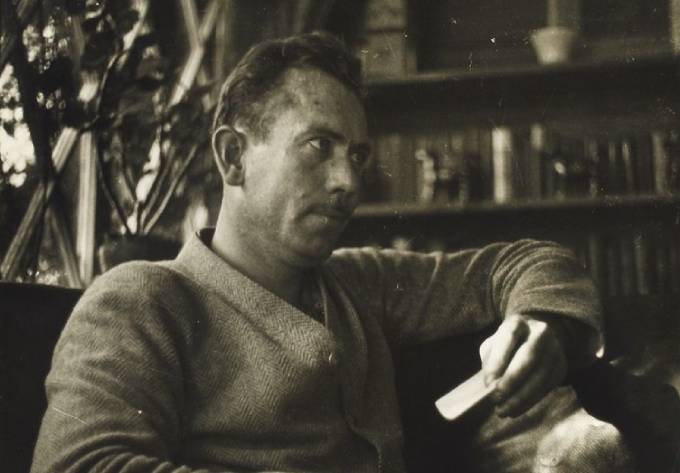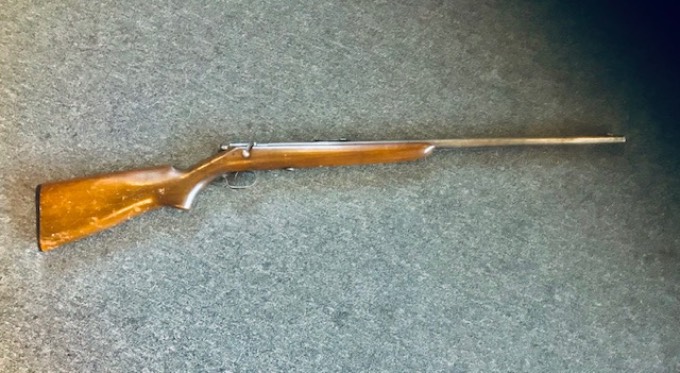In May of 1942, three years after writing The Grapes of Wrath, John Steinbeck wanted to arm himself with a Colt automatic for “self-protection.’’ He was living in New York, and the State of New York said he must get a license—something the recent 18-year old elementary shooter in Uvalde, Texas didn’t have to do.
New York said Steinbeck needed four character witnesses to get his license. It didn’t matter that The Grapes of Wrath had won the Pulitzer Prize, or that its author was famous. And no making things up: each character reference, the state demanded, “must be personally signed.” The actor Burgess Meredith and the artist Henry Varnum Poor added their names to John Steinbeck’s New York application. A veterinarian named Morris Segal and actress Sally Bates Lorentz also signed. Doing so took some courage. Steinbeck wasn’t politically popular, and his character witnesses had their own public careers. Could the Uvalde, Texas killer have found four witnesses to vouch for his 18-year old character?
But New York wasn’t satisfied with willing or even well-known character witnesses. It had another question for John Steinbeck: “Have you ever had a pistol license?” Steinbeck replied that he had, in 1938. Presumably he obtained that license in California. And, came another query, had he ever had a license application disapproved? Steinbeck replied, “No.” Well then, the state continued, had he ever had a gun license revoked or cancelled? “No” again. Steinbeck was then “sworn” that all his statements were true and that “the photo attached hereto was taken within thirty days prior to the date of his application.”
In short, the State of New York in 1942 wanted to know just who in the hell they were allowing to carry a firearm within its borders. Now, 80 years later, should Texas and other states think seriously about doing what New York did then, particularly when it comes to military-style weapons like the ones used to kill 19 schoolchildren and two teachers?
The Winchester Rifle John Steinbeck Gave His First Wife
I bring this up now because of the Uvalde, Texas massacre and the renewed debate about gun control in America, but also because I am looking at a rifle that John Steinbeck and his wife Carol owned and handled—another indicator that guns were a part of Steinbeck’s life from the 1930s to his death in 1968. The rifle is a Winchester Model 60-22, and Steinbeck gave it to Carol when they were married. Eventually it descended to Carol’s stepdaughter, Sharon Brown Bacon.
“I inherited the Steinbeck rifle from my father, William B. Brown, who was married to Carol Henning (Steinbeck) Brown for many years,” Bacon explains. “Carol, my stepmother, was John Steinbeck’s first wife and predeceased my father,” she continued. “I have always known the rifle to belong to Carol and that she was given it by John after they were married in 1930. At that time they were living in Los Gatos . . . . She used it, in her words, ‘for protection’ while alone there, and later at her home in Carmel Valley.”
Why did Steinbeck feel the need for a gun at all? A woman in Salinas told me years ago that she witnessed a man threatening Steinbeck with a gun in a Salinas park for what he was writing about their town in the run up to The Grapes of Wrath. The woman said she felt traumatized and thought Steinbeck probably did, too. This could be the origin story of the gun license Steinbeck obtained in 1938.
In 1946 and living in New York, Steinbeck wrote to a California friend, a motorcycle cop named George Dovolis, in care of the Monterey Police Department. He asked if Dovolis could ship him a “little thirty-eight,’’ which Steinbeck said he needed “for house protection.” We know Steinbeck had guns stowed away in Monterey or Pacific Grove because he wrote Dovolis, “I am very grateful to you for taking care of my guns while I have been away.” By 1948 Dovolis had transitioned to real estate, and Steinbeck wrote that he wanted to make him a gift of a gun in gratitude for past help.
In 1949 Dovolis, who would go on to found the still-flourishing Boys and Girls Club of Monterey County, returned the favor and shipped “1 box guns’’ to Steinbeck via Railway Express. So until May of that year, at least, guns were still on John Steinbeck’s mind—and about to arrive on his doorstep.
Thankfully, at least as far as we know, they were never used in self-defense. If one of them had been, it’s safe to assume it would have been properly licensed, including the signatures of character witnesses willing to testify that Steinbeck was a person who could be trusted to do the right thing. Perhaps it’s time for character witnesses to be brought back into America’s ongoing gun debate, post-Uvalde.




Fascinating history of John Steinbeck’s need to provide four character witnesses in order to own a gun. Given the lengthy legal process at that time, I have to wonder if, after all, the NRA and complicit GOP politicians have been planning for an insurrection and the overthrow of our republic. They certainly stood by as Trump bullied his way to the presidency and attempted a coup. And they stood with him within a few weeks of January 6, 2021. It is similar to the way they’ve gone about planning to take away women’s rights to abortion and the physical control of their bodies. They are not about to stop with either of these attempts to control our destiny. In Ohio they’ve brought forward a bill that would mandate a girl athlete challenged as to her gender, the girl must undergo a probing internal and external genital exam and blood draw to prove her legal to compete. And this is similar to the Texas bounty law on women and abortions.
No one should assume the current “gun problem” is one of gun ownership or access by citizens. The problem is due to the inability to keep firearms away from the mentally unstable who would use them to kill others. It is, in fact the deplorable mental health system in the USA mainly owned by Behaviorists who are unable to distinguish between the mentally ill and the sane using “statistically normal” as a standard. As a result of their ignorance, we’ve lost the languange, concepts, moels, and conceptual tools to scientifically describe the individual, as Stainbeck would with his Jungian expertise. He would strongly object to the behaviorist domination of the field of psychology.
I do think needing someone to attest to your character as far as owning or carrying a gun could be important and maybe save a life – there are some people I know, like and admire that I would not think should carry a gun for reasons of quick temper or other emotional issues. I would, with apologies, not sign for such an individual.
Before that happens, there must be a clear and uniform language, concepts, and conceptual tools to support such an evaluation and that simply does NOT exist at this point. It is why psychology is considered by many naural scientists to be a “soft science”. I know that Analytical Psychology (Jung) is based on empirical analytical science methods. Behaviorism is the dominant field in the USA at this point. Steinbeck was a brilliant Jungian.
One more comment then I will shut up. The gun shown in the photogram appears to be a shot gun with a 32 inch barrel and not a rifle.
Wes, the barrel is 23 inches long, the muzzle under 3/16th of an inch in diameter– it is a rifle, not a shotgun.
I believe you are correct after a closer look with my reading glasses.
Burgess Meredith stepping up to become a character witness for Steinbeck was reflective of Meredith’s own character – he was not afraid of putting himself out there. Several decades later, in 1965 or so, he directed two one-act plays by LeRoi Jones (later Amiri Baraka),”Dutchman” and “The Toilet,” at a theater called the Warner, on La Cienega Avenue in Los Angeles. Both plays had racial themes, but “Dutchman,” a really strong piece set on a New York City subway, had strong sexual strains to it too. The leads were originally played by Paul Winfield and Sheree North. Later the roles were taken by two more powerful actors (indicating that actors loved the roles), Al Freeman Jr. and Shirley Knight. The City of Los Angeles decided the plays were obscene, and the production was closed down every night, whereupon Meredith would appear with some kind of court order saying the plays could go on. So every night there was a one-act of the authorities and the feisty Meredith meeting on the stage. Then the plays would be performed. It was really an evening of three one-acts, and they sold out. What playwright wouldn’t love that kind of curtain raiser? Steinbeck, himself a playwright, must have loved it.
With the Supreme Court’s having just decided that New York’s restrictions on carrying guns are unconstitutional (thanks, Clarence Thomas, for finally having an opinion about something) we are left with even more freedom for inappropriate people to be packing their pieces in public. California has restrictions similar to those of New York, which means California’s law also will be weakened. Our pathetic attitudes about gun rights utterly bewilder Europeans and other sensible citizens of the world.
Let’s face facts all gun purchase and carry screenings have failed to keep psychotics from killing. There are no uniform standards in place to prevent crazy individuals from such acts. The over fourteen branches of psychology cannot agree on the basic meaning of important terms or the sources of an individual’s will to perform such violence.
Excuse this rant by a career libertarian, but Steinbeck — even with his drinking issues — was a law-abiding American who, on (constitutional) paper anyway, had every right to buy and own a handgun, rifle or shotgun without having to pass the state of New York’s absurdly rigorous and repressive screening test. From what little I know about him, he owned an assortment of weaponry that today would attract the attention of the FBI’s anti-terrorist department or at least earn him a spot on a local Red Flag list. I forget where I learned it, but when he went on his ‘Travels With Charley’ trip in the fall of 1960, he was packing a small arsenal in Rocinante and posing at times as sort of an anonymous itinerant hunter/outdoorsman. He wrote in ‘Charley’ that on his road trip he drew a bead on an unsuspecting coyote (in the California desert, if I recall) with a rifle but decided to be a nice guy and not pull the trigger. Let’s assume that was true. He also seemed to enjoy carrying a carbine and going out on patrol with soldiers in Vietnam. Before that in World War II he bravely went into combat with Douglas Fairbanks Jr. on some dangerous missions on small PT-like boats. I’m fuzzy on those details, so I’ll leave it to the professional Steinbeck scholars to try to divine what he’d think of today’s gun-ownership and gun-violence issues. But I bet Steinbeck’s ‘old-fashioned’ opinions about guns would get him cancelled in some liberal places today.
The 1911 Sullivan Law that was recently overturned by the SCOTUS was an attempt to keep pistols out of the hands of Italians, Jews, blacks and other people deemed undesirable by the power structure of the city of New York: https://nypost.com/2012/01/16/the-strange-birth-of-nys-gun-laws/
Robert,
thanks for that information. Good to learn.
I can’t believe there’s a John Steinbeck blog and I’m just now discovering it! I just wrote about applying a few of his lines from East of Eden to the personal finance world–hopefully something that hasn’t been covered!